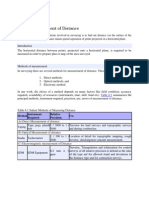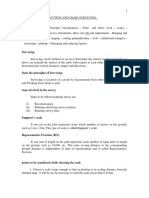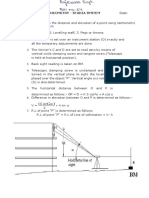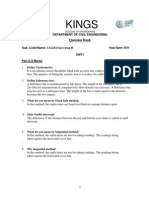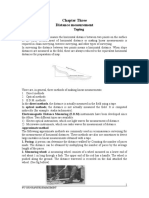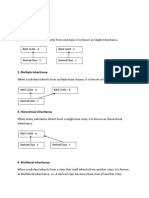Module 8 - Setting Out HZ Alignment - 10
Uploaded by
Hisham Abou HalimaModule 8 - Setting Out HZ Alignment - 10
Uploaded by
Hisham Abou HalimaModule 8 Surveying and Setting Out
8.3 Setting Out Horizontal Alignments
8.3.1 Responsibility for Setting Out
rior to construction, it is normal practice for the Surveyor to prepare a
detailed centre line survey. This centre line survey should normally consist
of stakes located every 20 metres on straights and every 5 to 10 metres
along curves. A mark is placed on each of these stakes defining the distance (up or
down) to the finished formation level of the road surface.
In order to relieve the surveyor from the onus of providing daily assistance to the
site, it is essential that the basic survey skills are available on site.
8.3.2 Setting Out a Straigth Line
traight lines are set out by marking points every 50m to 100m with ranging rods.
Between these ranging rods, intermediate points are set out at every 10m.
Normally, sections of not more than 50 to 100m are set out at the time. In
mountainous terrain, sections of less than 50m may be chosen.
In hilly or rolling terrain, when the line of sight between two fixed points is
obscured, the following method can be used to set out the straight.
Conditions :
From point A, ranging rods set at
points B and C must be visible.
From point D, ranging rods set at
points C and B must be visible.
Proceed as follows:
! From A, set B and C in a straight line.
! Sight from D and move C to be in line D-B
! Sight form A and move B to be in line A-C
Repeat this procedure until A-B-C and D-C-B show a straight line without further
movements.
Labour-based Works Technology Page 15
ASIST-AP International Labour Organisation
Module 8 Surveying and Setting Out
8.3.3 Setting Out Curves
The centre line is normally described by means of a series of straight lines meeting
at points of intersection. Eventually, these straights will be joined by curves that
will be set out during the detailed setting out.
The distance between the intersection points can easily be measured and used as a
first estimate of the length of the road to be constructed.
There are various methods to set out curves. With rural roads designed for low
traffic volumes, it is usually sufficient to follow existing tracks and to improve
existing curves where necessary. Two simple methods to set out circular and
parabolic curves using only a tape measure, ranging rods, pegs and strings are
described on the following pages.
Curves with a Small Radius
The figure below shows how a circular curve with a 30 meter radius is set out. This
method can only be applied when the area around the curve is easily accessible.
Labour-based Works Technology Page 16
ASIST-AP International Labour Organisation
Module 8 Surveying and Setting Out
The Intersection Method
The intersection method is a simple and effective method to set out a parabolic
curve. It requires simple equipment and can be easily understood by the foremen.
Step 1: First place a peg at the point where the two straight lines meet (intersection point
PI). Then locate the tangent points, TP. The first tangent point is where your curve
begins, and the second is where it ends. Divide the tangent lines in equal lengths,
by setting out a number of ranging rods along the tangent lines, at say 5m intervals.
With longer tangents, you will achieve a longer curve with a larger radius.
Deciding the length of the tangents is best done by experience. You will gain
experience in how to select the best tangent length. First look at the intersection
angle between the two tangents:
A large intersection angle (i) will produce an easy curve with a large radius. The
tangent length can then be short (however, not shorter than 20m).
A smaller intersection angle will give a sharper curve with a short radius. In such
situations, the tangent lines should be made longer (30, 40, 50 or 60m) to increase
the radius of the curve.
Sometimes, you will want to adjust the tangent length to control where the centre
line of the curve goes (see below: Adjusting the Position of the Curve).
Step 2: Give each ranging rod a letter as shown in the figure below. Sight along line a - a
with an assistant holding a ranging rod in your sight line. A second assistant stands
at point b and sights along the line b - b. Move your assistant along line a - a until
he also stands on line b - b. Mark this spot with a ranging rod and a peg. This is
your first point defining the curve.
Labour-based Works Technology Page 17
ASIST-AP International Labour Organisation
Module 8 Surveying and Setting Out
Step 3: Now repeat this exercise by sighting along b - b while an assistant is sighting along
c - c to find your next curve point.
Step 4: Complete the exercise for line c - c, d - d, etc. Finally, use these curve points to
set out intermediate points along the curve at 5 m intervals. Inspect the curve and
make sure that all the points provide a smooth curve.
Labour-based Works Technology Page 18
ASIST-AP International Labour Organisation
Module 8 Surveying and Setting Out
Adjusting the Position of the Curve
You always get one curve point less than the number of ranging rods on the tangent
length. For example, 5 ranging rods will give you 4 curve points (as above).
Even numbers of ranging rods gives uneven numbers of curve points, then the
middle curve point will be opposite the intersection point, PI. Where the middle
two lines intersect is the middle point of the curve (as below with 3-3 & 4-4 and 2-2
& 3-3).
If we increase the length of the tangent lines, the curve moves further away from PI.
We can use this when we need to set out the centre line of the curve to avoid
obstacles such as trees, buildings, boulders, etc.
8.3.4 Replacement of Pegs
There will often be a need for stakes to be replaced due to carelessness, children
playing near the site, theft for fire wood, etc. When the road alignment follows a
straight line there is no problem. The missing stakes are replaced by sighting and
measuring 20 meters between stakes using those remaining as a reference. If stakes
around a curve are missing, this poses a slightly more difficult problem.
However, it is not necessary to wait for a survey as the supervisor should be able to
replace curve stakes by using the following method.
Assuming the worst possible case, that is all stakes along the curve are missing,
including the tangent-point reference stakes.
It is necessary to know the length of the tangents BD and DC (ref. figure below).
These are usually the same, but can be different if necessitated by site conditions.
In this case, the curve is not a simple one but a compound of two curves. The
tangent length can be calculated from Radius R x Tangent A/2 where A is the
intersection angle in degrees.
Labour-based Works Technology Page 19
ASIST-AP International Labour Organisation
Module 8 Surveying and Setting Out
A simple way of estimating the intersection angle A is by placing a protraction on
the ground at intersection point D and reading the angle. If you cannot find a
protractor then use your watch. Five minutes on your watch equals 30 degrees. You
only need to be accurate to within 2 or 3 degrees to obtain the required tangent
length.
The intersection D can be located simply by sighting back along both tangent lines
until the intersection is found. With the tangent length calculated from the above
formula, the distance can be measured back in both directions (along the centre line)
and the tangent points B and C located and staked. The curve can then be reset by
tape measure or as shown in the above figure.
8.3.5 Off-Setting the Centre Line
Once the centre line survey has been established, it is desirable to establish
permanent references off-set from the centre line as the centre line pegs may be lost
during construction. These off-set pegs become the permanent markers for setting
out works, and provides an efficient reference for checking completed works. In
other words, these off-set pegs are used for planning, organising and measuring the
work.
Labour-based Works Technology Page 20
ASIST-AP International Labour Organisation
Module 8 Surveying and Setting Out
After the road works have been completed, those pegs will be retained to serve as
useful references for the maintenance supervisors.
Of crucial importance is that off-set pegs are located at right angles to the design
centre line. The following method illustrates a simple way of ensuring this using a
piece of string about 5 m long.
1. Mark the mid-point of the string and
layout as shown in the figure, line
ABD with B as the midpoint.
2. Drive in pegs at A and D.
3. Using the string, describe an arc from
A and D. Point C is the intersection
of the two arcs.
4. BC is now a right angle to the centre
line.
In flat and rolling terrain, the off-set distance is usually half the width of formation
plus the width of the side drains. This would apply to the off-set distance on both
sides of the road alignment as shown in the figure below.
Where the road passes through sloping ground, and side cuts are required, it is
necessary to locate a toe and a back-slope peg in order to fully define the road
alignment. Normally, the toe peg defines the outside shoulder edge on the low side
and the back-slope peg is that which defines the top of the back slope - the point of
incidence between the natural surface and the beginning of the back slope cut.
The location of the toe peg is the distance from the centre line to the outside
shoulder edge as defined by the cross-section.
The location of the back-slope peg involves understanding the relationship between
cross slope, back slope and formation width of the road. This relationship involves
the following calculations:
Labour-based Works Technology Page 21
ASIST-AP International Labour Organisation
Module 8 Surveying and Setting Out
Y
tan Q o ' (1)
X % Fw
where Q= Cross slope in degrees
Y= Height to back slope stake from finished formation level
Fw = Formation width of road
X= Horizontal distance to back slope stake additional to formation
width.
Engineering experience in the Philippines indicate that the back-slope should
normally be constructed at 1½:1 for reasons of stability and economy.
If this is the case then a relationship exists between X and Y, i.e,
1 X
tan P o ' '
1.5 Y
Y ' 1.5 X (2)
Thus (1) and (2) can be combined to determine one unknown, i.e,
X
tan Q o ' 1.5
X % Fw
Here, the only unknown is X, the additional horizontal distance from the centre line
peg to the back-slope peg. In other words, the off-set distance, from the centre line
peg to the back-slope peg is Fw/2 + X. The distance may be obtained using the
straight edge or using two profile boards and a line level as described in Section 8.2.
Labour-based Works Technology Page 22
ASIST-AP International Labour Organisation
Module 8 Surveying and Setting Out
8.3.6 Off-Set Elevation
Once the off-set pegs have been located in the horizontal plane forming a
"plan" of the road alignment on the surface of the ground, the shape of the
road in the vertical plane must now be defined by placing levels on the
off-set pegs. These levels define the distance down (-) or up (+) from
the top of the off-set pegs to finished formation level of the road.
During the initial survey of the road, centre line pegs are located and levelled. Thus
on every centre line peg is a level up (+) or down (-) from the top of the peg to the
finished formation level of the road. To transfer this centre line peg, level to the
off-set pegs, use the straight edge or a line level to determine the cross-slope of the
hillside and calculate "X".
From the figure below it can be seen that one end of the beam is placed on top of the
centre line peg. The spirit level is used to ensure horizontality of the beam and
obtain a measurement to the ground. This process may be continued until the toe
off-set is reached. Thus the summation of these measurements will provide the
exact excavation and fill levels of the centre line and the toe of the fill.
Equally, the same exercise is carried out to establish the difference between the top
of the back-slope and centre line pegs. It is essential that as level differences are
measured, a calculation is made using the centre line level data to complete the
levels up/down to the finished road formation level from the top of the toe and back-
slope pegs. A simple example follows to illustrate these points.
Labour-based Works Technology Page 23
ASIST-AP International Labour Organisation
Module 8 Surveying and Setting Out
Example:
At chainage 0 + 950, the level on the centre line peg reads (- 0.75) which means
that the finished formation level of the road is 75 cm (0.75 meters) below the top
of the peg.
Using the straight edge, a spirit level and a tape measure, the difference in levels
between the top of the back-slope peg and the top of the centre line peg is
found to be 1.35 meters. Using the same method, the difference in level
between the top of the centre line peg and the top of the toe peg is found to
be 1.05 metres.
Immediately calculations are made as follows;
(a) Difference in level from top of back-slope
to centre line peg is . . . . . . . . . . . . . . . . . . . . . . . . 1.35 m
Level on centre line peg is . . . . . . . . . . . . . . . . . . . . -0.75 m
Thus level from top of back-slope to finished
road formation level is . . . . . . . . . . . . . . . . . . . . . . . . -2.10 m
(b) Difference in level from top to centre line
peg and toe peg is . . . . . . . . . . . . . . . . . . . . . . . . . 1.05 m
Level on centre line peg is . . . . . . . . . . . . . . . . . . . . -0.75 m
Thus level from top to toe peg to
finished road formation level is . . . . . . . . . . . . . . . . . +0.30 m
Hint; it is always useful to draw a diagram of these measurement ensure accuracy
and immediately write the calculated levels on the off-set pegs.
Thus the off-set pegs now have a full set of information defining:
(i) the horizontal alignment and
(ii) the vertical alignment.
Labour-based Works Technology Page 24
ASIST-AP International Labour Organisation
You might also like
- Hourglass Workout Program by Luisagiuliet 276% (21)Hourglass Workout Program by Luisagiuliet 251 pages
- The Hold Me Tight Workbook - Dr. Sue Johnson100% (16)The Hold Me Tight Workbook - Dr. Sue Johnson187 pages
- Read People Like A Book by Patrick King-Edited62% (66)Read People Like A Book by Patrick King-Edited12 pages
- Livingood, Blake - Livingood Daily Your 21-Day Guide To Experience Real Health77% (13)Livingood, Blake - Livingood Daily Your 21-Day Guide To Experience Real Health260 pages
- COSMIC CONSCIOUSNESS OF HUMANITY - PROBLEMS OF NEW COSMOGONY (V.P.Kaznacheev,. Л. V. Trofimov.)94% (212)COSMIC CONSCIOUSNESS OF HUMANITY - PROBLEMS OF NEW COSMOGONY (V.P.Kaznacheev,. Л. V. Trofimov.)212 pages
- Donald Trump & Jeffrey Epstein Rape Lawsuit and Affidavits83% (1016)Donald Trump & Jeffrey Epstein Rape Lawsuit and Affidavits13 pages
- The 36 Questions That Lead To Love - The New York Times94% (34)The 36 Questions That Lead To Love - The New York Times3 pages
- The 36 Questions That Lead To Love - The New York Times95% (21)The 36 Questions That Lead To Love - The New York Times3 pages
- Jeffrey Epstein39s Little Black Book Unredacted PDF75% (12)Jeffrey Epstein39s Little Black Book Unredacted PDF95 pages
- The 4 Hour Workweek, Expanded and Updated by Timothy Ferriss - Excerpt23% (954)The 4 Hour Workweek, Expanded and Updated by Timothy Ferriss - Excerpt38 pages
- Handout For Surveying ARCH 3124 - Chapter 2No ratings yetHandout For Surveying ARCH 3124 - Chapter 218 pages
- Chapter 3 Distance Measurement - EditedNo ratings yetChapter 3 Distance Measurement - Edited13 pages
- Course Instructions: Click Here To Take Online ExamNo ratings yetCourse Instructions: Click Here To Take Online Exam33 pages
- Chapter Three Distance Measurement: TapingNo ratings yetChapter Three Distance Measurement: Taping18 pages
- Fge 431: Engineering Surveying A LEAD QUESTIONS 2020/2021No ratings yetFge 431: Engineering Surveying A LEAD QUESTIONS 2020/20213 pages
- Clearances Provided Between Two Adjacent Curved TracksNo ratings yetClearances Provided Between Two Adjacent Curved Tracks3 pages
- S. No. Date of Experiment Title of The Experiment No. Date of Submission Remarks 1No ratings yetS. No. Date of Experiment Title of The Experiment No. Date of Submission Remarks 139 pages
- Chapter Three Measuring Horizontal Distance100% (1)Chapter Three Measuring Horizontal Distance12 pages
- Chain Survey Notes Tape Errors and CorrectionsNo ratings yetChain Survey Notes Tape Errors and Corrections3 pages
- Malla Reddy Engineering College (Autonomous)No ratings yetMalla Reddy Engineering College (Autonomous)17 pages
- Standard-Slope Integration: A New Approach to Numerical IntegrationFrom EverandStandard-Slope Integration: A New Approach to Numerical IntegrationNo ratings yet
- Bresenham Line Algorithm: Efficient Pixel-Perfect Line Rendering for Computer VisionFrom EverandBresenham Line Algorithm: Efficient Pixel-Perfect Line Rendering for Computer VisionNo ratings yet
- The Big Picture - Deformation Monitoring: Equipment and Measurements Data Acquisition Using Surveying Field MethodologyNo ratings yetThe Big Picture - Deformation Monitoring: Equipment and Measurements Data Acquisition Using Surveying Field Methodology32 pages
- Booking & Calculations: Staff Readings: Level Book / Booking Form0% (1)Booking & Calculations: Staff Readings: Level Book / Booking Form29 pages
- Introduction To Surveying (BPD) : Levelling ProceduresNo ratings yetIntroduction To Surveying (BPD) : Levelling Procedures59 pages
- Surveying For Builders: Peter Southwell Probuild Constructions (Aust) Pty LTD Wednesday 28 July 2004No ratings yetSurveying For Builders: Peter Southwell Probuild Constructions (Aust) Pty LTD Wednesday 28 July 200422 pages
- Gurugram Bus Station: NCR Bus Time Schedule & Line MapNo ratings yetGurugram Bus Station: NCR Bus Time Schedule & Line Map7 pages
- Final Module 02 - Characteristics of An EntrepreneurNo ratings yetFinal Module 02 - Characteristics of An Entrepreneur8 pages
- Sea Marshall AU9 Operator Guide Rev 011 Low ResNo ratings yetSea Marshall AU9 Operator Guide Rev 011 Low Res56 pages
- Workers' Organization Development Program (Wodp) Dole-NcrNo ratings yetWorkers' Organization Development Program (Wodp) Dole-Ncr15 pages
- Livingood, Blake - Livingood Daily Your 21-Day Guide To Experience Real HealthLivingood, Blake - Livingood Daily Your 21-Day Guide To Experience Real Health
- COSMIC CONSCIOUSNESS OF HUMANITY - PROBLEMS OF NEW COSMOGONY (V.P.Kaznacheev,. Л. V. Trofimov.)COSMIC CONSCIOUSNESS OF HUMANITY - PROBLEMS OF NEW COSMOGONY (V.P.Kaznacheev,. Л. V. Trofimov.)
- Donald Trump & Jeffrey Epstein Rape Lawsuit and AffidavitsDonald Trump & Jeffrey Epstein Rape Lawsuit and Affidavits
- The 36 Questions That Lead To Love - The New York TimesThe 36 Questions That Lead To Love - The New York Times
- The 36 Questions That Lead To Love - The New York TimesThe 36 Questions That Lead To Love - The New York Times
- Jeffrey Epstein39s Little Black Book Unredacted PDFJeffrey Epstein39s Little Black Book Unredacted PDF
- The 4 Hour Workweek, Expanded and Updated by Timothy Ferriss - ExcerptThe 4 Hour Workweek, Expanded and Updated by Timothy Ferriss - Excerpt
- Course Instructions: Click Here To Take Online ExamCourse Instructions: Click Here To Take Online Exam
- Fge 431: Engineering Surveying A LEAD QUESTIONS 2020/2021Fge 431: Engineering Surveying A LEAD QUESTIONS 2020/2021
- Clearances Provided Between Two Adjacent Curved TracksClearances Provided Between Two Adjacent Curved Tracks
- S. No. Date of Experiment Title of The Experiment No. Date of Submission Remarks 1S. No. Date of Experiment Title of The Experiment No. Date of Submission Remarks 1
- Standard-Slope Integration: A New Approach to Numerical IntegrationFrom EverandStandard-Slope Integration: A New Approach to Numerical Integration
- Bresenham Line Algorithm: Efficient Pixel-Perfect Line Rendering for Computer VisionFrom EverandBresenham Line Algorithm: Efficient Pixel-Perfect Line Rendering for Computer Vision
- The Big Picture - Deformation Monitoring: Equipment and Measurements Data Acquisition Using Surveying Field MethodologyThe Big Picture - Deformation Monitoring: Equipment and Measurements Data Acquisition Using Surveying Field Methodology
- Booking & Calculations: Staff Readings: Level Book / Booking FormBooking & Calculations: Staff Readings: Level Book / Booking Form
- Introduction To Surveying (BPD) : Levelling ProceduresIntroduction To Surveying (BPD) : Levelling Procedures
- Surveying For Builders: Peter Southwell Probuild Constructions (Aust) Pty LTD Wednesday 28 July 2004Surveying For Builders: Peter Southwell Probuild Constructions (Aust) Pty LTD Wednesday 28 July 2004
- Gurugram Bus Station: NCR Bus Time Schedule & Line MapGurugram Bus Station: NCR Bus Time Schedule & Line Map
- Final Module 02 - Characteristics of An EntrepreneurFinal Module 02 - Characteristics of An Entrepreneur
- Workers' Organization Development Program (Wodp) Dole-NcrWorkers' Organization Development Program (Wodp) Dole-Ncr






























